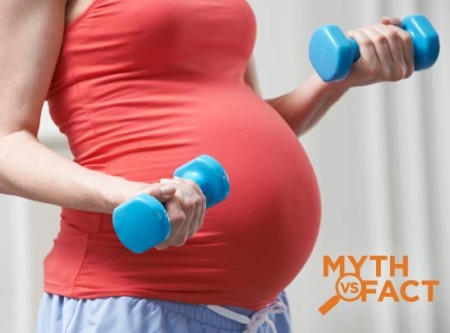
Most women can safely continue their regular exercise routines during pregnancy with some modifications.
Pregnant women may see concerned looks while they exercise and get advice to rest from well-meaning strangers.
Expectant mothers: Don’t hang up your running shoes or rack your weights just yet.
“Most pregnant women benefit greatly from exercise,” said Dr. Melissa Stoffel, a Marshfield Clinic OB-GYN physician. “Exercise helps women maintain physical fitness and reduces the risk of some pregnancy complications.”
Prenatal exercise myths and facts
Stoffel addressed the validity of some common exercise advice pregnant women hear:
Myth: Don’t start an exercise program during pregnancy.
False. It’s okay to start an exercise program slowly. Walking is a good starting point if you weren’t active before pregnancy. Jogging is safe if you feel comfortable.
Talk to your doctor before starting exercise. If you’re already active, let your doctor know what kind of exercise you normally do and what you plan to do during pregnancy.
Myth: Keep your heart rate under 140 beats per minute during exercise.
False. Doctors recommend women decrease the intensity of their exercise as pregnancy progresses, but a target heart rate of 140 isn’t right for every woman.
“Don’t get caught up in knowing your heart rate,” Stoffel said. “You should feel comfortable and be able to talk during exercise.”
Myth: Avoid exercises lying flat on your back after the first trimester.
True. “Lying flat on your back for an extended time period can reduce blood flow to the baby,” Stoffel said. Modify exercises after the first trimester using an incline bench or exercise ball.
Myth: Don’t do core exercises while you’re pregnant.
False. “You can do core exercises, including sit-ups and planks, as long as you feel comfortable,” Stoffel said.
Doing core exercises during pregnancy won’t increase or decrease your chances of developing abdominal separation, known as diastasis recti.
Myth: Don’t lift heavy weights.
Mostly false. If weightlifting was part of your pre-pregnancy workout routine, you can continue at the same level. Modify workouts as your pregnancy progresses by using lighter weights or switching from free weights to machines if you feel off balance.
“Focus on maintenance rather than increasing strength or building muscle during pregnancy,” Stoffel said.
It’s okay to continue lifting children and objects around your home that you’re used to carrying. Your doctor probably will recommend restrictions if you frequently lift heavy objects for your job.
Exceptions for high-risk pregnancies, emergencies
Women who have high-risk pregnancies should not do any exercise other than leisurely walking, Stoffel said.
Stop exercising and seek medical attention if you have any of these symptoms, even if you’ve had an otherwise healthy pregnancy:
- Vaginal bleeding
- Leaking fluid
- Shortness of breath
- Chest pain
- Contractions
- Change in your baby’s movement
Returning to exercise postpartum
Moms who were active before pregnancy may be eager to start exercising after they give birth.
Stick to walking the first four weeks after delivery, Stoffel said. If you feel ready, you can start doing other exercise after four weeks. Listen to your body and wait longer if you need to.
Exercise shouldn’t reduce your milk supply if you drink plenty of water and wait the full four weeks to work out.

